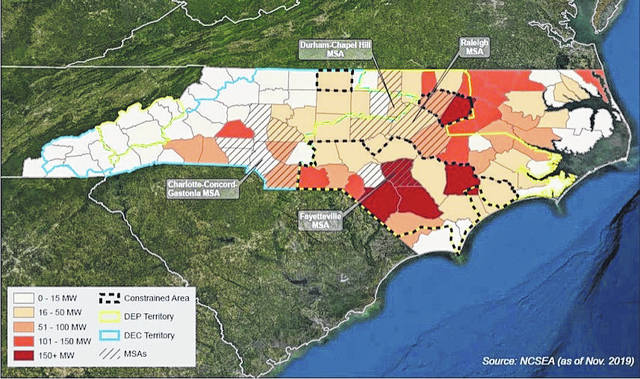ELIZABETHTOWN — Commissioners have endorsed the efforts to increase solar farm opportunities for Bladen County and 14 others.
Their action, a letter to the N.C. Utilities Commissioner ahead of a Wednesday meeting, supports Birdseye Renewable Energy and its request for a Friesian Holdings Certificate of Public Convenience and Necessity. The letter reads in part that commissioners “see that the Friesian upgrades are the best way to continue Bladen County solar investment in a timely manner.”
Brian Bednar, owner of the company, appeared before the board with a well-crafted advocacy for the Friesian Solar Project in Scotland County and how it impacts Bladen County. He included a PowerPoint presentation, and answered a litany of questions that came from eight of the nine panel members.
Friesian is a 70 megawatt project developed by Birdseye that would be next among all others in the state to obtain a CPCN. The company has a pending deal to sell power from Friesian to the N.C. Electric Membership Corp., a pact contingent on power moving from the solar facility via Duke Energy transmission lines.
Capacity for those lines in this area has maxed out, Bednar said. Upgrades are necessary to support any additional solar development from a 15-county region in the southeastern part of the state stretching from Anson and Montgomery counties to the coast.
As proposed, Birdseye has identified 63 miles of lines and would handle the $225 million cost to upgrade them. There would be no new construction of power lines. The earliest completion date is about four years away, in 2023, after which Duke would then pay back the cost through its rate base.
The Utilities Commission must sign off on the project for it to go forward. Duke has endorsed it, and Bednar said several other government entities have as well.
The southeastern part of the state is one of three areas restricted by being at capacity on the transmission lines.
“This is the most productive area, and there was available land, so now we’ve reached the point where those lines are at capacity,” Bednar said.
The other two areas are Rockingham County along the Virginia state line, to the north of Greensboro, and adjoining counties Franklin and Nash, to the northeast of Raleigh.
“Duke has put forth a plan to reduce the carbon footprint,” Bednar said. “It’ll require an additional 3,000 megawatts of solar. The governor’s Executive Order 80 wants to reduce utility carbon footprint by 40 percent below 2005 levels by 2025. That’s another 2,100 megawatts.
“We’re the only way the 15 counties in that map will see that happen. If we don’t go forward, Duke has said the earliest these upgrades could be completed would be 2027.”
Bednar said his company began work in 2016. He described the process as six to seven years.
In his presentation, Bednar said increased solar development is the only way to achieve the governor’s goal. Without the needed upgrades identified, investment will go to other parts of the state, most likely in western North Carolina.
The presentation highlighted benefits to the county that include solar development, associated jobs and training, new industry attracted to renewable energy and some tax benefits. The latter includes a $96 million investment in the Slender Branch project, which is projected to yield $157,440 in first-year property revenue to Bladen County coffers.


Bladen County is in a 15-county region that is without ability to develop solar industry, due to transmission lines being maxed out.

